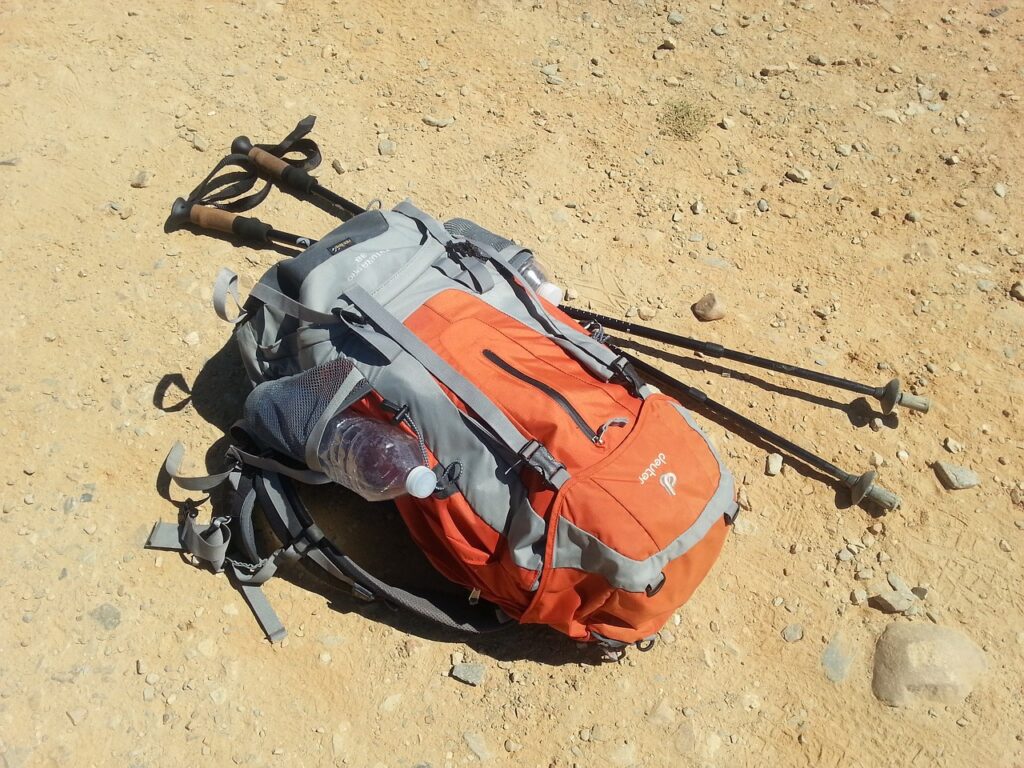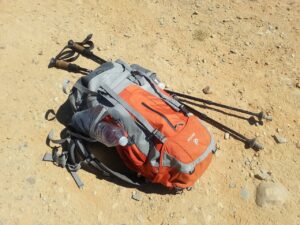Last Updated on April 3, 2024 by ETC Team

When choosing a backpack, its fit and features are the two key factors when making a decision. You need your backpack to be a helpful partner during your hiking adventures. Remember, it carries the bulk of your items and you carry it! Below we’ll cover the things to consider when looking for the best hiking backpack features.
1. Backpack frame types
Internal-frame: Most modern brands supply form-fitting internal-frame packs. These frames have load lifting capabilities to increase stability and comfort on uneven trails and backcountry. Unlike external-frames, internal-frame packs settle most weight on your waist.
External-frame: External-frames were the first packs to dominate the market. These frames are designed for heavy loads and wide trails. The rectangular (and often aluminum) frame sits high on your back and provides great ventilation.
Frameless: Cheaper than their external and internal frame counterparts, frameless packs are ideal for hikers who seek simpler and lighter designs. Some packs offer removable frames.
2. Ventilation
For those with sweaty backs, ventilation is vital. Many internal-frame packs provide suspended mesh back panels that allow airflow between your back and pack. This allows you to stay cool and dry when carrying a heavy load.
Backpacks with tension mesh suspension separate your back and pack with breathable mesh. These packs encourage air flow far better than foam air channels, which provide no separation.
3. Fit Adjustment
Load Lifters: Load lifter straps are common on high volume backpacks. They attach the shoulder straps to the top of the back panel and help shift weight forward. This feature is unnecessary in smaller volume packs with low weight capacity.
Sternum Strap: The sternum strap determines the width of your shoulder straps to allow greater arm movement and prevent excessive pack movement.
Compression Strap: Compression straps are a standard feature found on the side of a pack. They are primarily used to increase balance and comfort by consolidating weight to the frame. These straps provide many other creative uses such as space for fishing rods, ice axes, or dirty laundry.
Adjustable Torso: While packs with fixed torso lengths are lighter, they are limited in size. Adjustable torso systems allow you to optimize comfort by fitting the frame exactly to your torso length. The right torso size will shift most of the weight to your hips, rather than your shoulders. This allows for better balance and less fatigue.
4. Pockets, Pockets, Pockets
Side Pockets: Don’t drop your backpack to get some water. Elasticized side pockets are useful for holding water bottles and loose objects.
Hip-Belt Pockets: These compartments allow easy access to smaller items such as granola bars or your phone.
Shovel Pockets: Originally used for snow shovels, these large pockets are attached to the front of a backpack. They are ideal for holding larger, lightweight items.
5. Pack Access
Panel Access: A front-loading backpack provides a panel to access the full pack interior. This provides easy and quick access to items within your pack.
Top Loading Openings: Top-loading backpacks are the standard. Some have a bottom or side access point. Both of these features ease access to gear deep in your pack.
6. Weather Resistance
Preparation is key for any outdoor adventure. Many packs have features to ensure you’re ready for rain, wind, or snow. Although many packs are water resistant, not all are waterproof .
A rain cover encompasses the entire pack and prevents water from seeping through zippers and seams. Additionally, a rain cover wicks off extra moisture that the exterior may absorb, causing water weight.
7. Hydration
Most packs include an internal sleeve to insert a hydration reservoir/water bladder. These may be included or sold separately.
8. Removable Daypack
Some high volume backpacks may include a removable daypack for summit hikes or short trips. These may come in the form of detachable top lids that convert into a hip-belt pack.
9. Sleeping Bag Compartment
To optimize space, this is a zippered compartment at the bottom of a pack for a sleeping bag.
How To Fit A Hiking Backpack

Fit is everything. A well-fitted backpack is essential to maximize performance and comfort.
Step 1: Selecting the Right Size
Your torso length is the key measurement when choosing a pack. To determine this height, tilt your head forward and begin the measurement from a bump where your shoulders meet your neck. End the measurement at the top of your hip bones (the iliac crest).
Pro Tip: Ask a friend for help and use a flexible tape measure.
Another aspect to consider is gender specific packs. While many women use male-specific backpacks and vice versa, there are a few key differences. In general, women’s packs are shorter and narrower. They offer a shorter torso range, narrower shoulder straps, and different hip belts. Although this should not be a major determinant when choosing a pack, gender-specific backpacks offer many unique and helpful features.
Step 2: Fit Adjustment
To maximize comfort and efficiency, backpacks have four fundamental adjustment straps: load lifters, sternum strap, shoulder strap, and hip-belt. These are used to adjust the majority of your pack’s weight on your hips.
First, load lifter straps attach the shoulder straps to the top of the back panel and help shift weight forward. These straps should be tightened to around a 45-degree angle to minimize shoulder tension.
Second, the sternum strap determines the width of your shoulder straps. The strap should allow arm movement and be raised to an inch below your collarbones.
Third, the shoulder straps should snuggly wrap around your shoulders. However, be careful not to over tighten them – this will quickly fatigue your shoulders, neck, and upper back.
Finally, the hip-belt should sit on the top of your hip bones and comfortably fit. To raise or lower the hip-belt, adjust the shoulder straps.
How To Pack And Organize A Hiking Backpack

Step 1: Bottom Zone
This section is for lightweight, bulky items not needed until the end of the day. This includes camp gear like a sleeping bag and pad.
Step 2: Middle Zone
The heaviest gear is packed in the middle and towards your back. Items like a stove or bear canister go here.
Step 3: Top Zone
Once the heavy items have been packed, place trail essentials in the top of your pack. This enables easy access to important gear like a rain jacket or first-aid kit.
How To Wash And Clean A Hiking Backpack
If you love your pack you will want to use it a lot and if you use it a lot, it will get dirty. In your adventures you’ll encounter everything from spilled food to mud-caked pockets. Your backpack’s brand will likely have instructions, but there are some standard cleaning and care tips you should know.
First, never machine wash or dry your pack. Use a mild soap and soft sponge in lukewarm water. Harsh chemicals, hot water, and heavy scrubbing will degrade the pack fabric quality and water resistance. Next, dry the pack away from direct sunlight where the UV rays may deteriorate the fabric. To remove dust and crumbs from zippers, carefully clean without scrubbing.
Many backpacks will go years without cleaning. To get most of the dirt and camp smoke out, remove the hipbelt and shoulder straps if possible. Submerge these and your pack in lukewarm water with mild soap. Lightly sponge the dirty spots, drain the soapy water, then rinse out all soap residue.
Pro Tip: Gently use a vacuum to remove cookie crumbs and loose dirt in backpack crevices.
How To Fix A Backpack Zipper
Before trying to fix a zipper, check if your pack’s brand does repairs. For example, all Ospreys are covered by their All Mighty Guarantee which ensures free repairs and replacements (including for zippers). Seek professional help if you need to replace the entire zipper.
However, if you are gear-repair-savvy or just looking for a quick fix, here are some pro tips for common zipper problems.
A Stuck Zipper Slide: Often, it is a piece of dirt or crumb that prevents a zipper slider from moving. Try using a toothbrush to remove extra grime. If the slider still doesn’t move, you may need to replace the zipper.
Separated Zipper Teeth Or Teeth Won’t Mesh: For a quick fix, use needle-nose pliers to squeeze the slider and stopper together. If the zipper continues to malfunction, you will need to replace the slider. To change the slider, remove it with pliers and replace with an identical size (listed on the back). Next, wedge the new slider onto the top zipper teeth and wiggle until it connects to the bottom teeth.
Bent Zipper Teeth: This is easily fixed with a pair of needle-nose pliers and careful shaping.




[…] Weight and size are two of the most important factors to consider when you choose binoculars for hiking. The weight should be as light as possible, preferably under a pound, and it should be compact enough to fit in a backpack. […]